Editorial: The Animals Are Waiting
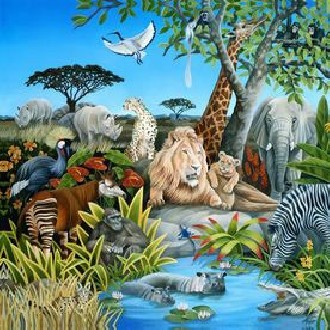
Painting and copyright © 2010 by Laura Regan
The image from which we take our name, the "Peaceable Kingdom" scene of Isaiah 11, is loved by many. For those who are unfamiliar with the Biblical passage, it may be helpful to quote it:
"The wolf shall dwell with the lamb, the leopard shall lie down with the young goat, the calf and the lion and the fattened calf together; and a little child shall lead them. The cow and the bear shall graze; their young shall lie down together; and the lion shall eat straw like the ox. The nursing child shall play over the hole of the cobra, and the weaned child shall put his hand on the adder's den. They shall not hurt or destroy in all my holy mountain; for the earth shall be full of the knowledge of the Lord as the waters cover the sea."
The scene has often been portrayed by artists, not least Fritz Eichenberg, the German-American refugee from Nazism, from one of whose versions of the scene (see PT 5 ) the cameo on our masthead is derived. Other favorite renditions are those of William Strutt, 1896, and the many by Edward Hicks early in the nineteenth century.
Peace Beyond the Walls of the World?
The image is a moving one. Its appeal has not diminished in the twenty-five hundred years since it was created, suggesting that it expresses a deep truth about ultimate reality, a state of peace beyond our space-and-time world cursed by predation and violence since long before there were humans. There have long been intimations of its reality. Mystics and Near-Death experiencers (NDErs) have described entering a transcendent peace and unity in which they experience all reality as one, and that one good. An NDEr, actor Jayne Smith, felt this unity from the inside when she approached death during childbirth in 1952: "This enormously bright light seemed almost to cradle me. I just seemed to . . . be part of it and be nurtured by it and the feeling just became more and more ecstatic . . . . I knew that everything, everywhere in the universe was OK, that the plan was perfect. That . . . the wars, famine, whatever . . . . it was all a part of the perfection . . . . you're home forever. That you're safe forever. And that everybody else was." In his Varieties, William James summarizes this state: "It is as if the opposites of the world, whose contradictoriness and conflict make all our difficulties and troubles, were melted into unity. " (See "Neither Wickedness Nor Sorrow," WilliamJ )
But what good does this deep truth encountered by mystics and visionaries do for the animals who are suffering and dying? They cannot count on having transcendent experiences which will lessen their anguish, their sense of something terribly unjust inflicted on them now; they long for liberation and healing in this world. Thus however profoundly true the message of such mystical experiences is, knowing of them cannot release us from the prophetic imperative to denounce violence and work toward peace and healing for all. (In fact those who have Near-Death experiences tend to become active seekers of peace and healing themselves.)
Thy Kingdom Come
Actually, the Isaiah text does not present the scene as eternal, but as something that is going to happen; its verbs are in the future tense. "The wolf shall lie down with the lamb. . . the lion shall eat hay like the ox . . . a little child shall lead them." In Romans 8, Paul also envisions such a cosmic transformation as a coming event: "the creation itself also will be set free from its slavery to corruption into the freedom of the glory of the children of God." In both passages, human beings lead the way, making it possible for animals to attain this divine peace and fulfillment.
Unhappily, there are no clear signs that the great day is approaching. The natural evil of predator attacking prey has not diminished; the moral evil of human attacking animal, especially for the table, has increased hugely in numbers and descended ever lower in depravity. There is no need to repeat the all-too-familiar statistics running into billions. Why then do we continue to hope for and expect the Peaceable Kingdom? For it is not only evangelical Christians who look to see it realized. Occasionally other people of faith, influenced by the concept of evolution, have included animals in their hope that ". . . the days are hastening on / By prophet bards foretold, / When with the ever-circling years / Comes round the age of gold. / When peace shall over all the earth / Its ancient splendors fling . . . ."
Katherine Hulme, reflecting on a saying of G. I. Gurdjieff, specifically places our four-footed cousins in this process:
"The animals are waiting for us to move up so they can follow" . . . . This was the answer I had been unconsciously groping for ever since my first confrontation with Africa's wildlife. This surely was why the animals' long, slow stares took us in, unaware that they were waiting for us to "move up" that ladder that Jacob saw in his dream, thronged with angels moving up and down . . . ."
Assuming that such an evolutionary process is taking place (a large assumption), of what nature might it be? Hulme speaks of it as occurring by the "immutable laws of evolution and involution," which suggests that the change will come about inevitably, whatever we do as individuals, groups, or humanity as a whole. Or might its nature be conditional, perhaps hastened by positive moral and spiritual developments in humanity, slowed by massive evils? It is of course very difficult to speak with certainty about such a matter, which is so much vaster than the scope of our view, whether we think in terms of decades or centuries.
Hastening the Day
Of the various positive human actions that might in fact in fact hasten the process, one that has been put forward is meditation/contemplative prayer, especially when many persons unite in the practice. Mystics from the major religious traditions who engage in meditation/contemplation have sometimes claimed that despite their generally reclusive manner of living, they are influencing the world for the better. As with the effectiveness of prayer overall, certainty on this issue has long been elusive. But since the mid-1970s there has been a long series of social-science experiments in Transcendental Meditation (TM) in groups, which strongly indicate that violence does in fact decrease and movements toward peace and understanding increase (among humans) during the weeks in which large numbers of experienced meditators meet together daily in specific cities. For example: in Washington, D.C. during June and July 1993, meditators gathered, increasing in number over the four weeks until they reached 4,000. Over the same period, violent crime against persons decreased as the number of meditators increased, until it was 23% less than the average for June and July during the preceding five years. (Other variables were controlled.) Afterwards the crime rate returned to "normal."
An earlier experiment with fewer meditators was carried out in Providence, Rhode Island, in June of 1978. According to figures cited in The Maharishi Effect, statistics for a number of social ills, including suicide, homicide, robbery, and traffic deaths, changed markedly for the better (other variables being controlled), though they went back to their usual rates after the meditators decamped. It certainly does look as though during the time that many people jointly cultivate unity with the Ultimate, whether seen as God or the Ground of Being, other people in the area become more peaceful.
We might even speculate that Oscar, the cat whose self-appointed task is to accompany the dying in Providence's Steere House nursing center (see book review in Oscar ), is a late fruit of residual energies from this experiment; Oscar's ability to perceive the coming of death, and respond supportively, perhaps compassionately, shows him to be at a higher level of spiritual evolution than most. Of course we cannot know with certainty . But in regard to our present concern, reduction of inter-animal violence, admittedly I know of no studies of the effects of these group meditation experiments on the levels of predation among animals, say wild omnivores. But because all the living are linked in so many ways, it seems quite possible. If omnivores in fact do less killing during these periods, the idea that large-group meditation or contemplation might promote overall spiritual evolution would gain a solider basis.
Anything like proof that the Peaceable Kingdom is coming nearer, or that we can hasten it by meditation/contemplative prayer as well as political and social action, is still elusive. Ther experiments strongly suggest that such (contemplation and) meditation have real power to reduce crime and other social evils. But for now we remain dependent on the visions of mystics, the intuitive gleams of poets, the promises of prophets.
And the animals are still waiting.
--Gracia Fay Ellwood
Sources: Isaiah 11: 6-9; "It Came Upon a Midnight Clear" by Edmund Sears; Heading Toward Omega by Kenneth Ring; Look a Lion in the Eye by Katherine Hulme; "Effects of Group Practice . . ." (See Group Meditation ); The Maharishi Effect by Elaine Aron and Arthur Aron. The Peaceable Kingdom painting is from the website of Laura Regan; see LRegan . Used by permission.
Unset Gems
from reluctant prophets and messengers
 "O my Lord, I pray, send somebody else." --Moses
"O my Lord, I pray, send somebody else." --Moses
"If this is the way You treat Your friends, it's no wonder You have so few of them." --Teresa of Ávila
"I know God will not give me anything I can't handle. I just wish He didn't trust me so much."--Teresa of Calcutta
NewsNotes
Written in One Another's Heart
For the fifth year in a row, a stork named Rodan flew the eight thousand miles from South Africa back to his mate, Malena, who cannot leave the village of Brodski Varos in Croatia, because a hunter's bullet through her wing disabled her. A villager named Stjepan Vokic cares for her during Rodan's absence.
from the Costa International newsletter
Australian Alliance to Protect Wild Life Formed
Representatives of the Indigenous people of Australia met in Canberra and on May 5 formed the Australian Alliance for Native Animal Survival (AAFNAS). The idea arose in 2008 in response to the continuing massacres of kangaroos in the Australian Capital Territory, carried out over the heads of the Aboriginal people, climaxing many extinctions since Europeans arrived in 1788. The Alliance intends to build a grassroots organization, tap into the ancient knowledge of the Indigenous people, educate the Australian and international communities and gain their support to preserve the continent's unique flora and fauna, re-establish land rights, and allocate resources for safe areas for native species.
--Contributed by Marian Hussenbux
"Pinkwashing"
John Robbins has a new essay on HuffingtonPost entitled "Greed, Cancer, and Pink Buckets" about an odd-couple alliance: the major breast cancer advocacy group, "Susan G. Komen for the Cure," and KFC. Until the end of May, KFC agrees to donate to Komen fifty cents for every pink bucket of fried chicken they sell. Well, well. Who would have thought that to cure cancer, what we need to do is eat fried chicken, heterocyclic amines and all? See PinkBucket .
--Contributed by Maria Elena Nava and Lorena Mucke
Slaughterhouses Linked to Crime Rate
There is evidence of an increased rate of violent crimes in areas near slaughterhouses. Amy Fitzgerald, criminology professor at University of Windsor, studied this possible link by crunched numbers from the FBI’s Uniform Crime Report database, census data, and arrest and offence reports from 581 U.S. counties from 1994 to 2002. Her results indicate that as the number of slaughterhouse workers in a community increases, the crime rate also increases. See Slaughtercrime . These phenomena may be of the same nature as the decrease in crime related to group meditation.
--Contributed by Lorena Mucke
A Glimpse of the Peaceable Kingdom
Under His Wings
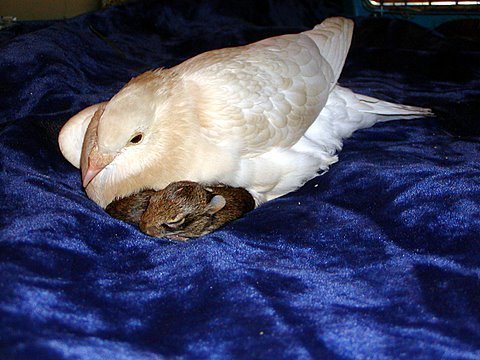
Photo by Bob Lenham
We have seen pictures of mother dogs who have adopted orphaned kittens or piglets--wonderful enough--but who would have believed a male dove fostering baby bunnies? For more pictures and a fuller story, see Mother Dove .
--Contributed by Karen Borch
Letter: Rosemary Carlson
Dear Peaceable Friends,
I'm just discovering your vegetarian site, and frankly, I can't begin to tell you how much I appreciate the enormity of the work involved in organizing and making available an online a newsletter which includes relevant
articles and book reviews written by mostly individuals who have searched within themselves, in order to search for their role as well as ours in taking responsibility for the ongoing suffering of all sentient beings.
As I often do when finding a new and interesting vegetarian website, I searched your archives and, after reading many very conscientious and thoughtful authors, I am stunned to find Temple Grandin, co author of Animals Make us Human. Why? Because as a collaborator and designer of slaughterhouses (supposedly to offer a kinder - gentler death to animals grown for food, an oxymoron), those of us who do not have autism can, however, communicate very well with animals, and we ascertain that these innocent beings are smarter and more sensitive than the claims made by Grandin, especially considering that these highly evolved animal prisoners are keenly aware of the horror to befall them and will not and cannot be placated by Grandin's special abilities to any meaningful extent.
Likewise, just as I am recovering from this book review, I find another book review for Peter Singer, another self proclaimed animal welfare activist. Indeed, what Singer loudly proclaims in his books is that stealing food from innocent beings is normal and strict/pure vegetarians are too rigid and severe and are simply denying themselves the occasional choice in enjoying animal flesh! Moreover, Singer has blatantly stated that the animals we kill at will and consume don't really care whether they live or die, but rather only how we treat them!
Not only is this statement absurd and speaks to . . . deadened sensibilities, but it is also an example of our violent culture of denial of cruelty and our will to decide whether and when we will randomly attack helpless animals for our own pleasure. What Singer lacks, fundamentally, is a bas[ic] insight into understanding what animals truly want --which is (as anyone knows who spends time with nonhuman animals) to live freely in their own community and according to their own wishes and needs. . . .
In summary, the problem with writers like Grandin and Singer showcased in The Peaceable Table is that, unless otherwise clearly stated, it is very likely that readers may find writers like these, whose pseudo claims of animal compassion all but negate the philosophy of nonviolence and plant based eating. Instead, the concept of nonviolence becomes muddled, confusing, and unclear to those who may be close to a paradigm shift in their thinking and their ability to relate compassionately to all sentient beings. . . .
The Animal Kinship Committee, sponsor of The Peaceable Table, is also committed to a nonviolent, abolitionist stance regarding our animal cousins; we hold that keeping animals against their will as property is slavery, and killing them for food is morally equivalent to murder (though most people who participate do not consciously intend this). But we are willing to make alliances at times with welfarist groups, because the public tends to reject rapid and radical change, whereas they are more open to small steps.
When we review a book, we are not per se endorsing the author's other writings, views, or actions. I personally think Grandin's continuing to eat flesh is not excusable, and her work for the slaughterhell system ill-advised; Benjamin Urrutia, the reviewer, is in general agreement, and expressed his opinion in the review. I also don't agree with some of Peter Singer's other views. But we are willing to affirm valid insights we find in any work we review--as we would want our opponents to do for us. We reject violent, destructive outlooks, actions, and institutions, but not individuals, because of our core commitment to the presence of God-with-us: meaning that all beings continue to bear the Divine Light/Love, whether its presence is evident in their lives or not.
--Editor
Film Review: Furry Vengeance
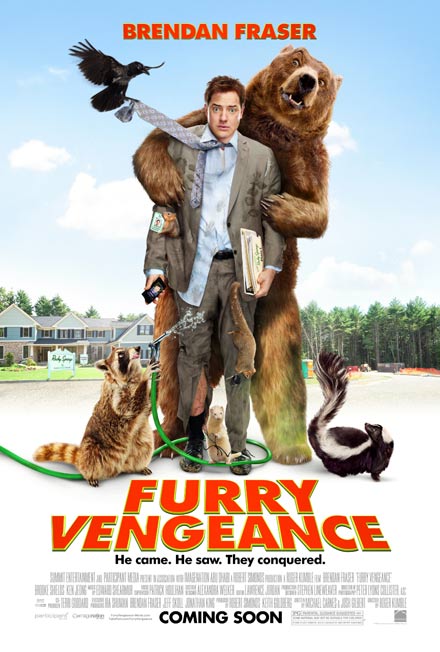 Furry Vengeance. A 2010 film directed by Roger Kumble. Starring Brendan Frazer as Dan Sanders, Brooke Shields as his wife Tammy Sanders, and Matt Prokop as their son Tyler.
Furry Vengeance. A 2010 film directed by Roger Kumble. Starring Brendan Frazer as Dan Sanders, Brooke Shields as his wife Tammy Sanders, and Matt Prokop as their son Tyler.
A construction company assigns employee Dan Sanders (played by Brendan Frazer, who put on 30 pounds for the role) to be the executive in charge of paving over a forest and replacing it with a suburban development. The forest inhabitants, led by a very intelligent female racoon, choose to react by directing a series of vicious attacks on Sanders. While this choice of victim is perhaps understandable, tactically and logically, it would have been better for them to use their cleverness and inventiveness to sabotage the construction machinery. Or they might have directed their attacks to the company's CEO--a very greedy and truly despicable individual--or to the construction foreman, who is very gung-ho on blowing up the beaver dam. But tactical prudence is not a guiding principle here.
At one point, Sanders captures the racoon at gunpoint. He could have killed her, but instead he proposes peace talks, only to have the critter respond by biting him in the groin. This was the lowest point in a movie that provides very few smiles, and no laughs at all. It is a small wonder that 93% of the reviews have been negative. The wonder is that the negativity is not 100%. And for once the public agrees with the critics, staying away in droves from this humorless "comedy."
However, even from such regrettable film-making one may learn some lessons. The main one is that violence and terrorism should not be used in defense of animal rights. To use a violent approach is not only morally wrong, it is counter-productive; it turns the public away from, not toward, a pro-animal position. As somebody (only half tongue-in-cheek) once said: "It is worse than a crime; it is a blunder."
I must acknowledge that the animals, probably mostly animatronic and computer-generated, look very real. However, technical excellence is an insufficient virtue when not backed by a morally sound and viable position.
One thing I did enjoy about this movie: the ending, largely because it is the ending, but also because it features the whole cast--good and bad, animals and humans--doing a big song and dance. This is the way The Blues Brothers, Slumdog Millionaire, Hannah Montana, and other films close, and I find it very satisfying. I would be happy to see all movies end this way. The ending is not, however, sufficient to redeem Furry Vengeance, which I cannot recommend to anyone. In fact, I was reluctant to write this review at all, because I have a strong aversion to writing animadversions.
-Benjamin Urrutia
Film Review: How to Train Your Dragon
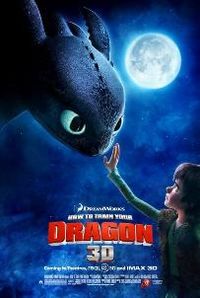 How to Train Your Dragon. A Dreamworks computer-animated film, directed by Chris Sanders and Dean DeBlois. Starring Jay Baruchel as the voice of Hiccup and America Ferrera as the voice of Astrid. Based on the book by Cressida Cowell.
How to Train Your Dragon. A Dreamworks computer-animated film, directed by Chris Sanders and Dean DeBlois. Starring Jay Baruchel as the voice of Hiccup and America Ferrera as the voice of Astrid. Based on the book by Cressida Cowell.
A village on an island in the North Sea is populated by fierce Viking Warriors who wage an endless war against flying, fire-breathing dragons. A teenager named Hiccup wants to prove himself as a dragon-slayer, but he faces an uphill road. He is small, scrawny, physically weak, uncoordinated, accident-prone. However, he is very skilled in construction, and brings down a dragon with a bola-catapult of his own device. The creature is at his mercy. But when he looks into the golden eyes of the black-scaled dragon, the boy simply cannot bring himself to slay the animal in cold blood. Instead of killing, he sets him free.
Later, he finds the black dragon inside a crater with a lake at its bottom. Having lost half of his tail, he cannot fly higher than the crater walls. Hiccup, amazing boy, actually constructs a prosthetic half-tail for his new friend, whom he names Toothless (he does have teeth, but they are small ones, not visible when his mouth is closed). Soon the lad becomes the first-ever dragon-rider. How they become friends is reminiscent of E.T., The Black Stallion, and The Forgotten Kingdom.
The friendship of these two who are supposed to be mortal enemies is at first a secret, but Hiccup soon shares it with Astrid, a pretty but fierce Viking girl (blonde and blue-eyed, but voiced by America Ferrera, a dark-haired and dark-eyed Hispanic actress--a sweet and pleasing irony).
The film conveys an anti-violence and pro-animal message. Those whom we consider our enemies can become our friends, if we make the effort to communicate --a point that applies to animals as well as to humans.
The animation is beautiful and exciting. The scenes in which Toothless and Hiccup (and Astrid, sometimes) are flying above the clouds are breathtakingly beautiful. There once was a time when a black dragon would have been ipso facto considered the embodiment of evil. I am so glad we seem to be evolving beyond that. I think a black animal with golden eyes is as beautiful as can be.
The book was originally published in the United Kingdom as authored "by Hiccup Horrendous Haddock III, translated from the Old Norse by Cressida Cowell." There are many differences between the book (the first of a series of, so far, eight books) and the film. However, Ms. Cowell has said that the changes were needed for the transition from one medium to another, and her essential message has been preserved.
Recommended enthusiastically for all ages.
-Benjamin Urrutia
Recipes
Pasta, Peas & Panko
Serves 4
1 lb. pasta (fusilli is a good choice)
3 - 4 T. extra virgin olive oil
½ tsp sea salt, or to taste
Freshly ground black pepper, to taste
1 cup walnut pieces
2 T. pignoli (pine nuts) (optional)
1 T. nutritional yeast
2 T. chopped fresh parsley
2 cups fresh or frozen green peas (If using frozen peas, allow to thaw before adding to recipe)
1 clove garlic, minced
1 tsp. organic lemon zest, grated
¼ cup organic Panko (Japanese bread crumbs), lightly toasted
Cook pasta in boiling water al dente. Meanwhile, in a small bowl mix together walnuts, pignoli, nutritional yeast, ½ tsp. sea salt (or to taste), lemon zest, parsley, garlic, and green peas.
While pasta is cooking, toast Panko in skillet with 2 tsp. olive oil. Careful not to burn. Set aside.
When pasta is finished cooking, drain, place in serving bowl, and add 2 T. olive oil. Toss pasta with olive oil to coat. Add walnut-pea mixture. Toss again to mix. Sprinkle with Panko and a generous grind of black pepper. Drizzle as desired with extra virgin olive oil. Toss again to blend all ingredients and serve.
I like fusilli pasta in this dish because it catches and holds the flavors of the herbs and lemon zest. If pignoli are not readily available, it's okay to omit them, but they do add a subtle yet very distinct flavor to this dish.
I used Edward & Sons brand Panko. For their website, see Edward & Sons . It is a vegetarian company; however, not all of their products may be vegan. They use the vegan icon to label products as such.
-- Angela Suarez
Cheeze Scones
makes 8 scones
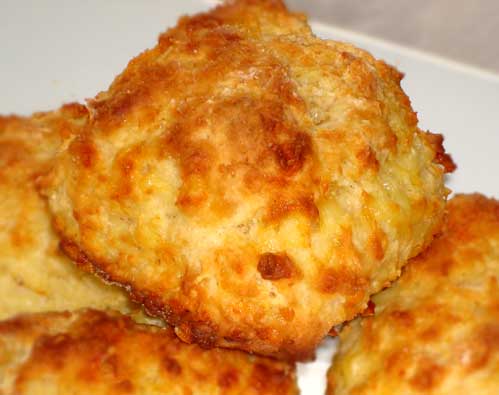 1 ¾ cup organic unbleached flour
1 ¾ cup organic unbleached flour
1 ½ tsp. baking powder
¼ tsp. soda
½ tsp. sea salt
¼ cup Earth Balance® buttery spread, cut into pieces (½ stick)
¼ cup Medium Sharp Sheese® OR Follow Your Heart® cheddar
⅔ cup plain soy milk
¾ tsp. apple cider vinegar
Preheat oven 425° F.
Combine soymilk with apple cider vinegar in small glass bowl and set aside. This creates a flavorful “buttermilk.” In the bowl of a food processor, combine flour, baking powder, baking soda and salt with Earth Balance. Process until crumbly. Add the grated Sheese® or Follow Your Heart® cheddar, and pulse just until combined. With the motor running, add the milk to make a soft dough. Turn on to a floured sheet of parchment paper and knead very lightly. Roll into a round ¾ inch thick. Cut into wedges.
Brush the tops of the scones with a little soymilk. Bake for 15 minutes or until well risen and golden.
Serve with Earth Balance® buttery spread.
For the website of Sheese®, see Sheese .
For the website of Follow Your Heart® , see Heart . Vegan cheese alternatives can be found by clicking on Vegan Gourmet products. These cheese alternatives are also gluten free.
--Angela Suarez
The photo is by Lucy Hoffman. To see her website, go to LucyH
Pioneer: Jennifer Raymond
Wings Are to Fly
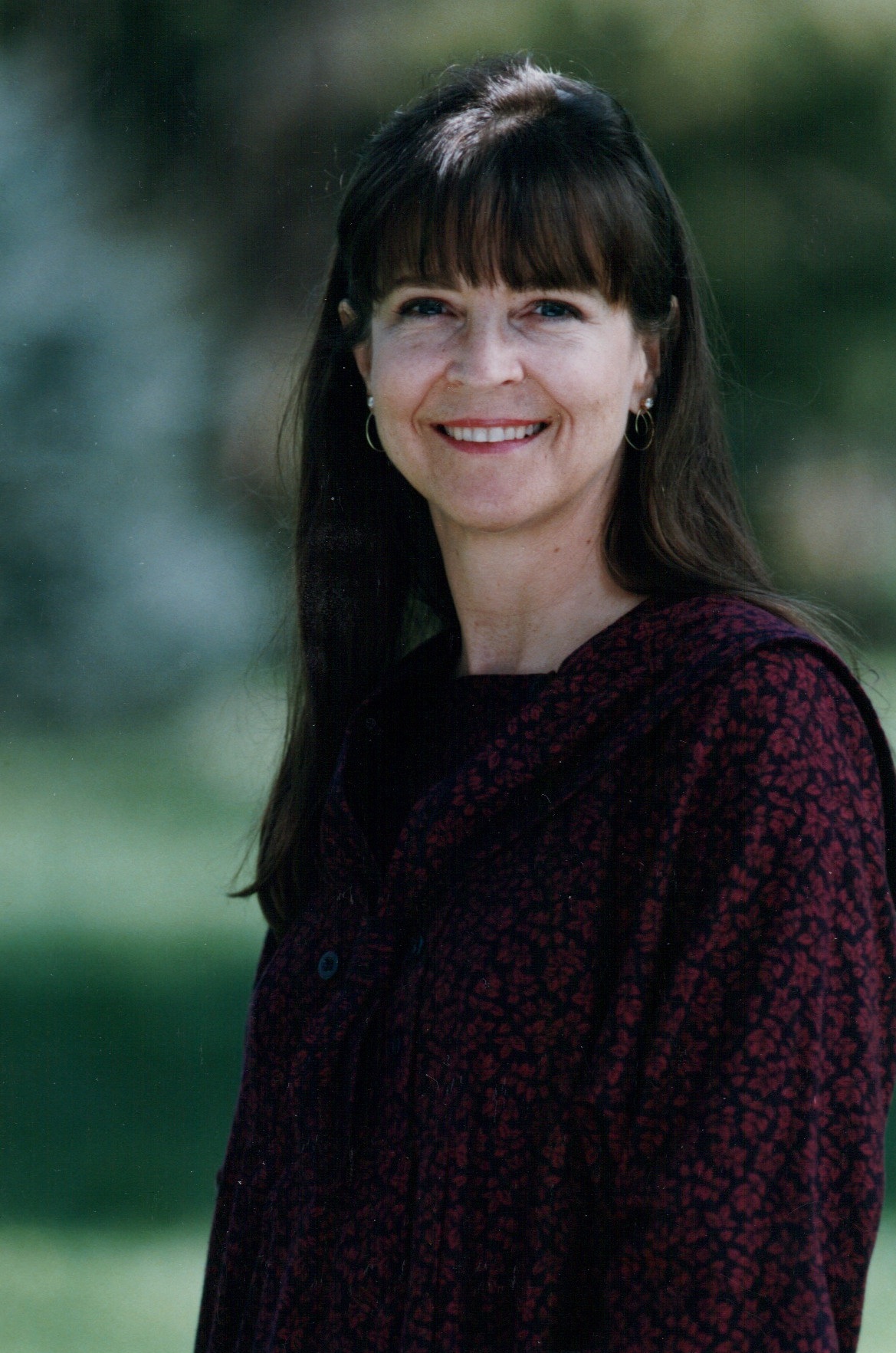 Growing up in Bakersfield, California, in the 1950s, Jennifer Raymond never heard the word "vegetarian." But she has loved animals for as long as she can remember, and felt compelled to help those in need from a very early age. Unfortunately, her parents did not share her convictions and whenever she brought home a stray animal she was instructed to find it a home elsewhere. "When you grow up, you can have all the animals you want," her mother told her.
Growing up in Bakersfield, California, in the 1950s, Jennifer Raymond never heard the word "vegetarian." But she has loved animals for as long as she can remember, and felt compelled to help those in need from a very early age. Unfortunately, her parents did not share her convictions and whenever she brought home a stray animal she was instructed to find it a home elsewhere. "When you grow up, you can have all the animals you want," her mother told her.
The Birds and the Wing
When she was seven her family moved to a neighborhood where some boys were amusing themselves by shooting birds with BB guns. One day Jennifer went outside and, to her grief, found the bodies of two (American) blackbirds these heroes had killed. It turned out that the birds were new parents, with babies nesting nearby and cheeping hungrily. She supplied herself with a shoebox, climbed the tree, and took the orphans home.
Little blackbirds, unlike orphans of some other species, are quite easy to raise; they accepted food from Jennifer and showed their appreciation. Four or five days into this new schedule of avian infant care, the small foster mother sat down to dinner and found on her plate--a chicken wing. Light dawned. "I can't eat this wing!" she protested. When asked if she wanted a drumstick instead, Jennifer explained that wings come from dead birds, and that she loved the babies in her room and all other birds and animals, so she couldn't eat them any more.
Her mother told her that without meat she wouldn't get enough protein, and that she would die; her grandmother later seconded this warning, saying that she wouldn't live beyond age twenty. But Jennifer was adamant: she would rather die than eat meat from animals that were killed. "But these animals are raised so kindly, and killed in such a gentle manner . . ." The child still wasn't having any, and the mother finally accepted her choice, making sure that her stubborn daughter got plenty of cheese and eggs. Her father took her decision as a personal affront, saying "Why do you hate us so much?"--a bewildering question for a seven-year-old prophet.
Mr. Four-by-Four
About two years later, Jennifer and her best friend Doris, whose parents owned a feedlot, were enjoying the company of a young steer Doris was raising. Mr. Four-by-Four was friendly and gentle; he would follow the two children around, would lie down and let them snuggle against him. Both girls were very fond of him. When Doris exhibited her prize young steer at the county fair, Jennifer found out that he was to be auctioned off, and after that--the slaughterhouse. "But you can't let them kill Mr. Four-by-Four!" Now fully realizing what was coming, Doris went to her mother to protest this terrible betrayal of their friend. Her mother's response was to go into a rage and demand that Doris have nothing more to do with Jennifer. Mr. Four-by-Four died by violence, and so did the girls' friendship.
Developing the Negative
Still a vegetarian (and still alive!) when she was college age, Jennifer did not forget her mother's and grandmother's dire predictions of her early death. When she went to UC Davis in 1969, she soon enrolled in a course in nutrition. She was told much the same thing, in longer words--complete proteins were essential, and only meat supplied them. But she remained dubious, and did some extracurricular investigating. Now the scene began to change radically. Studies of Seventh-Day Adventists showed that vegetarians had lower rates of various degenerative diseases than meat-eaters. Early reports from heart disease studies confirmed their findings--fewer heart attacks, fewer strokes. And on and on. It was as though she had been sold a photographic negative as reality. Now seeing the picture in its true colors, she found she was likely to live longer than her friends and family. She wanted (and still wants) to share this good news with everyone.
Jennifer also did not forget her mother's assurance that the animals they ate were raised and killed very gently, and here too she was determined to learn for herself. Fortuitously, UC Davis was a leader in promoting factory-farm practices, and the animal studies classes she took included field trips. She saw calves in veal crates, pregnant pigs in farrowing crates, dairy cows locked into stalls, young heifers having their horns burned off, young pigs having their tails and teeth cut off, chickens crammed in battery cages. She also saw a slaughterhouse in operation. As with nutrition, the animal scene was the opposite of the pretty landscape sketched for her at age seven: it was more like a 3-D film of hell.
Telling the Truth
Jennifer knew that she had to get both the bad news and the good news to as many people as she could, and as effectively as she could. But it was clear that just showing and telling the horrors was not the optimal approach. Many don't want to face up to all that pain. Either their eyes glaze over, or, temporarily moved, people consider a change. But finding that most things in their refrigerators are involved, they throw up their hands and go back to the usual. What they needed was to be re-educated about food, to be shown how many healthy, tasty, and colorful dishes can be made from plants. Jennifer decided to become a dietitian, not in a hospital but in a classroom, opening the way to well-being for humans and animals alike. Many of her students responded favorably, with a "why wasn't I told before?" element of indignation.
A major part of the answer to that question, of course, has to do with the power of the meat, dairy and egg industries. One of Jennifer's concerns for years was to make vegetarian entrees available in public school lunches, which are heavily weighted toward animal products for reasons not exactly altruistic. There were other possibilities, but peanut butter or beans cannot compete with pizza or hamburgers in children's minds. Soy-based meat analogues were called for, but soy products were not allowed to fill the protein requirement. Jennifer visited the undersecretary in charge of the USDA's school lunch program as part of an effort toward getting the law changed. But he told her, "We can't get this changed until the cattlemen approve it." (!) The cattlemen's organizations, she found, had tentacles everywhere. She learned of such unsavory facts as the cruel programs of the Bureau of Land Management to clear "public" lands of their residents, such as bison and wild horses, so that the cattlemen can graze their beef-on-the-hoof there. (Too often our government operates not by the Golden Rule but the Gold Rule: those with the gold make the rules.) Another discouraging development about that time was the huge popularity of the high-protein diets demonizing "carbs" and pushing flesh eating.
Non-Retirement
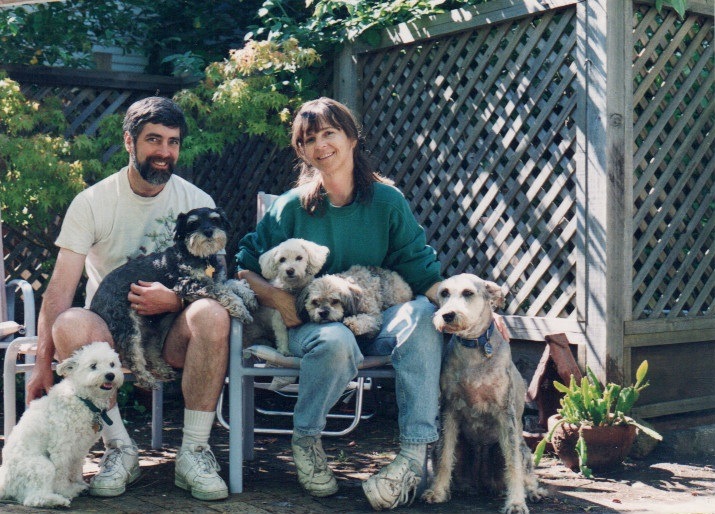
After 22 years of teaching, Jennifer decided to retire from teaching in 2000, and, with her husband, moved to Humboldt County in northern California. In addition to cooking and gardening, she now runs a spay and neuter program for dogs and cats that has helped reduce the number of killings of unwanted animals in the Humboldt County from 3500 yearly to 600. She takes in various four-footed waifs; at present, besides tending to her own animal friends-in-residence (four dogs, ten cats, forty-seven birds, two fish, and three horses), she is taming nine feral kittens to ready them for adoption. She also serves as a manager for seventeen student apartments, a job she backed into rather than seeking it out. Thus, though she has no children of her own, she mothers fifty-seven 20-year-old humans in addition to numerous furry and feathered persons, and is much loved by her proteges of both persuasions.
Of course, she has not really stopped teaching; in her cookbooks she continues to convey to a wide audience that there is a vast cornucopia of tasty and colorful things to prepare and enjoy. Her recipes are mostly based on common, familiar ingredients, making them more accessible to new vegetarians. She also communicates her message in many informal contacts. She has learned patience and gentleness, releasing overly high expectations, being ready to encourage warmly those who take small steps such as giving up red meat.
Jennifer sees those who resist the message as having experienced a moment when they realized just what meat really was, but flipped the switch off. Deep down, they still know. But when they receive a reminder from persons like herself and others, the guilt is triggered, and to avoid it they either shut down communication on the issue, or react with hostility, as her father and Doris' mother did. They are not heartless--it's that they are unwilling to deal with what is in their hearts. Nevertheless, they remain part of the Family of all that live.
Kinship with all life is the foundation of Jennifer Raymond's being.
--Gracia Fay Ellwood
Based on an interview May 26, 2010.
Jennifer Raymond is the author of The Peaceful Palate, The Best of Jenny's Kitchen, and Fat-Free and Easy. She created the recipes for several of Neal Barnard's books, including Foods That Fight Pain.
A Little Child Shall Lead: Olivia Susan "Susy" Clemens, 1872-1896
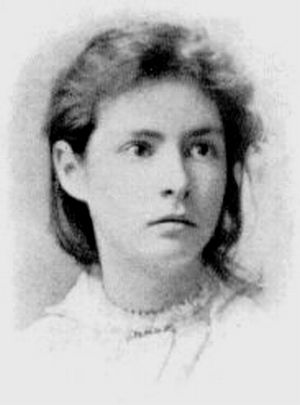 "Apparently Susy was born with humane feelings for the animals and compassion for their troubles. This enabled her to see a new point in an old story, once, when she was only six years old--a point which had been overlooked by older and perhaps duller people for many ages. Her mother told her the moving story of the sale of Joseph by his brethren, the staining of his coat with the blood of a slaughtered kid, and the rest of it. She dwelt upon the inhumanity of the brothers, their cruelty towards their helpless young brother, and the unbrotherly treachery which they practiced upon him; for she hoped to teach the child a lesson in gentle pity and mercifulness which she would remember. Apparently her desire was accomplished, for the tears came into Susy's eyes and she was deeply moved. Then she said, 'Poor little kid!'"
"Apparently Susy was born with humane feelings for the animals and compassion for their troubles. This enabled her to see a new point in an old story, once, when she was only six years old--a point which had been overlooked by older and perhaps duller people for many ages. Her mother told her the moving story of the sale of Joseph by his brethren, the staining of his coat with the blood of a slaughtered kid, and the rest of it. She dwelt upon the inhumanity of the brothers, their cruelty towards their helpless young brother, and the unbrotherly treachery which they practiced upon him; for she hoped to teach the child a lesson in gentle pity and mercifulness which she would remember. Apparently her desire was accomplished, for the tears came into Susy's eyes and she was deeply moved. Then she said, 'Poor little kid!'"
from The Autobiography of Mark Twain by Samuel L. Clemens, pp. 198-99
--Contributed by Benjamin Urrutia
This strong empathy for animals was shared by Jane, another of Mark Twain's daughters. Appropriately, "Clemens" is Latin for "merciful."
Poetry: Francis Thompson (1859-1907)
From The Mistress of Vision

WHERE is the land of Luthany,
Where is the tract of Elenore?
I am bound therefor.
‘Pierce thy heart to find the key;
With thee take
Only what none else would keep;
Learn to dream when thou dost wake,
Learn to wake when thou dost sleep. . . .
Plough thou the rock until it bear;
Know, for thou else couldst not believe;
Lose, that the lost thou may’st receive;
Die, for none other way canst live.
When earth and heaven lay down their veil,
And that apocalypse turns thee pale;
When thy seeing blindeth thee
To what thy fellow-mortals see; . . .
Search no more—
Pass the gates of Luthany, tread the region Elenore.’
Where is the land of Luthany,
And where the region Elenore?
I do faint therefor.

‘When to the new eyes of thee
All things by immortal power,
Near or far,
Hiddenly
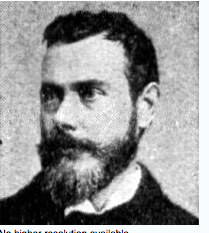 To each other linkèd are,
To each other linkèd are,
That thou canst not stir a flower
Without troubling of a star;
When thy song is shield and mirror
To the fair snake-curlèd Pain,
Where thou dar’st affront her terror
That on her thou may’st attain
Perséan conquest; seek no more,
O seek no more!
Pass the gates of Luthany, tread the
region Elenore.’
The Peaceable Table is
a project of the Animal Kinship Committee of Orange Grove Friends Meeting, Pasadena, California. It is intended to resume the witness of that excellent vehicle of the Friends
Vegetarian Society of North America, The Friendly
Vegetarian, which appeared quarterly between 1982 and
1995. Following its example, and sometimes borrowing from its
treasures, we publish articles for toe-in-the-water
vegetarians as well as long-term ones.
The journal is intended to be
interactive; contributions, including illustrations, are
invited for the next issue. Deadline for the July issue
will be June 27, 2010. Send to graciafay@gmail.com
or 10 Krotona Hill, Ojai, CA 93023. We operate primarily
online in order to conserve trees and labor, but hard copy
is available for interested persons who are not online.
The latter are asked, if their funds permit, to donate $12 (USD) per year (checks should be made out to Gracia Fay Ellwood). Other
donations to offset the cost of advertising (in The Christian Century) are welcome.
Website: www.vegetarianfriends.net
Editor: Gracia Fay Ellwood
Book and Film Reviewers: Benjamin Urrutia & Robert Ellwood
Recipe Editor: Angela Suarez
NewsNotes Editors: Lorena Mucke and Marian Hussenbux
Proofreaders: Idarmis Rodriguez and Robert Ellwood
Technical Architect: Richard Scott Lancelot Ellwood

 "O my Lord, I pray, send somebody else." --Moses
"O my Lord, I pray, send somebody else." --Moses 

 Furry Vengeance. A 2010 film directed by Roger Kumble. Starring Brendan Frazer as Dan Sanders, Brooke Shields as his wife Tammy Sanders, and Matt Prokop as their son Tyler.
Furry Vengeance. A 2010 film directed by Roger Kumble. Starring Brendan Frazer as Dan Sanders, Brooke Shields as his wife Tammy Sanders, and Matt Prokop as their son Tyler. How to Train Your Dragon. A Dreamworks computer-animated film, directed by Chris Sanders and Dean DeBlois. Starring Jay Baruchel as the voice of Hiccup and America Ferrera as the voice of Astrid. Based on the book by Cressida Cowell.
How to Train Your Dragon. A Dreamworks computer-animated film, directed by Chris Sanders and Dean DeBlois. Starring Jay Baruchel as the voice of Hiccup and America Ferrera as the voice of Astrid. Based on the book by Cressida Cowell. 1 ¾ cup organic unbleached flour
1 ¾ cup organic unbleached flour Growing up in Bakersfield, California, in the 1950s, Jennifer Raymond never heard the word "vegetarian." But she has loved animals for as long as she can remember, and felt compelled to help those in need from a very early age. Unfortunately, her parents did not share her convictions and whenever she brought home a stray animal she was instructed to find it a home elsewhere. "When you grow up, you can have all the animals you want," her mother told her.
Growing up in Bakersfield, California, in the 1950s, Jennifer Raymond never heard the word "vegetarian." But she has loved animals for as long as she can remember, and felt compelled to help those in need from a very early age. Unfortunately, her parents did not share her convictions and whenever she brought home a stray animal she was instructed to find it a home elsewhere. "When you grow up, you can have all the animals you want," her mother told her.
 "Apparently Susy was born with humane feelings for the animals and compassion for their troubles. This enabled her to see a new point in an old story, once, when she was only six years old--a point which had been overlooked by older and perhaps duller people for many ages. Her mother told her the moving story of the sale of Joseph by his brethren, the staining of his coat with the blood of a slaughtered kid, and the rest of it. She dwelt upon the inhumanity of the brothers, their cruelty towards their helpless young brother, and the unbrotherly treachery which they practiced upon him; for she hoped to teach the child a lesson in gentle pity and mercifulness which she would remember. Apparently her desire was accomplished, for the tears came into Susy's eyes and she was deeply moved. Then she said, 'Poor little kid!'"
"Apparently Susy was born with humane feelings for the animals and compassion for their troubles. This enabled her to see a new point in an old story, once, when she was only six years old--a point which had been overlooked by older and perhaps duller people for many ages. Her mother told her the moving story of the sale of Joseph by his brethren, the staining of his coat with the blood of a slaughtered kid, and the rest of it. She dwelt upon the inhumanity of the brothers, their cruelty towards their helpless young brother, and the unbrotherly treachery which they practiced upon him; for she hoped to teach the child a lesson in gentle pity and mercifulness which she would remember. Apparently her desire was accomplished, for the tears came into Susy's eyes and she was deeply moved. Then she said, 'Poor little kid!'"

 To each other linkèd are,
To each other linkèd are,